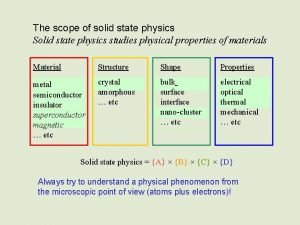Name these changes of state Solid liquid Liquid


- Slides: 2

Name these changes of state: Solid liquid Liquid gas Gas liquid Gas solid Liquid solid Sketch a graph to show the temperature change when ice is heated from -50°C to 150°C. Label where ice melts and the water boils Describe how the density of particles changes when wax melts Sketch a graph to show the temperature change when steam is cooled from 150°C to -50°C. Label where steam condenses and the water freezes C 1 Particles C 1. 1 The Particle Model Describe how the movement of particles changes when ice melts Draw a particle diagram for a solid Similarities Links 1. 2 Atomic Structure 2. 1 Purity and Separating Substances 5. 2 Controlling Reactions Describe how the movement of particles changes when water boils Draw a particle diagram for a liquid Draw a particle diagram for a gas Differences Describe how the forces of attraction are different in: Water and ice Explain the shape of this curve Water and steam Keywords Describe how the density of particles changes when water evaporates

Write C next to the chemical changes and P next to the physical changes below: Frying an eqg Melting an ice cube Dissolving salt in water Making a cup of tea Baking a cake Plants growing Respiration Cutting the grass What might you observe if a chemical reaction was occurring? 1. 2. 3. Draw a particle diagram showing water evaporating Draw a particle diagram showing hydrogen gas reacting with oxygen gas to produce liquid water C 1 Particles Links C 1 The Particle Model 1. 2 Atomic Structure 2. 1 Purity and Separating Substances 5. 2 Controlling Reactions Why is it easier to separate a mixture of hydrogen molecules and oxygen molecules than to separate the oxygen and hydrogen atoms in water? Draw a particle diagram for an element Draw a particle diagram for a compound Draw a particle diagram for a mixture Similarities Differences When metals and non-metals react with oxygen, how are the oxides that form different? What are the typical properties of metals? What are the typical properties of non-metals? Keywords



